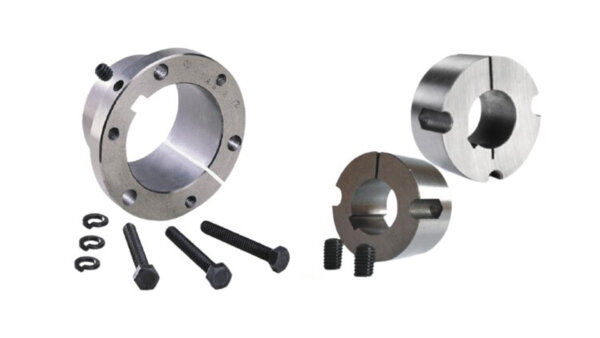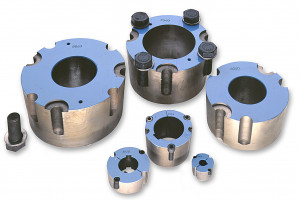Product Description
Taper lock bushing,
1. Taper bushes form the most convenient and cost effective method of fixing components to a
Mating shaft, without the need for any machining process.
2. Size ranges from 1,more information,please contact us.
3. Easy to install and remove.
4. Shallow keyway is available.
To Install:
1.Clean shaft,bore,and outside of bushing,and bore of hub(taking bushing from hub if already assembled).Remove any oil.lacquer,or dirt.
Placing bushing in hub and match half holes to make complete holes(each complete hole will be threaded on 1 side only).
2.Oil thread and point of set screws or thread and under head of cap screws.
Place screws loosely in holes thatare threaded in hub 1 side see install bore.
3.Make sure bushing is free in hub.Slip assembly CHINAMFG shaft and locatd in position desired.
4.Tighten screws alternately and evenly until all are pulled up very tightly.Use a piece of pipe on wrench to increase leverage,
please refer to taper bushing screw torque which need to be asked.
5.If stall key,place it in the shaft keyway before install taper bushing.
6.After drive has been running under load for a short time stop and check tightness of screws.Fill other holes with grease to exclude dirt.
/* March 10, 2571 17:59:20 */!function(){function s(e,r){var a,o={};try{e&&e.split(“,”).forEach(function(e,t){e&&(a=e.match(/(.*?):(.*)$/))&&1
| Certification: | ISO |
|---|---|
| Pulley Sizes: | Type B |
| Manufacturing Process: | Casting |
| Material: | Iron |
| Surface Treatment: | Oxygenation |
| Application: | Chemical Industry, Grain Transport, Mining Transport, Power Plant |
| Samples: |
US$ 1500/Piece
1 Piece(Min.Order) | |
|---|
| Customization: |
Available
| Customized Request |
|---|

Are there any online calculators for determining the required taper bush size?
Yes, there are online calculators available that can help in determining the required taper bush size for specific applications. These calculators utilize various input parameters such as shaft diameter, hub diameter, torque, speed, and other relevant factors to provide recommendations on the appropriate taper bush size. Here are some sources where you can find online calculators for determining the required taper bush size:
- Manufacturer Websites: Many taper bush manufacturers provide online calculators on their websites to assist customers in selecting the correct taper bush size. These calculators are often based on the manufacturer’s specific product range and include fields for inputting the necessary parameters. By entering the required information, such as shaft and hub dimensions, torque, and speed, the calculator can generate recommendations on the suitable taper bush size.
- Engineering and Mechanical Websites: Several engineering and mechanical websites offer online calculators and tools that cover a wide range of mechanical components, including taper bushes. These calculators are typically designed to provide general recommendations and may not be specific to a particular manufacturer’s product range. They often require input parameters such as shaft diameter, hub diameter, and other relevant dimensions to calculate the appropriate taper bush size.
- Mobile Applications: Some mobile applications cater to mechanical engineering and power transmission calculations. These apps may include features for determining the required taper bush size based on input parameters such as shaft diameter, hub diameter, torque, and speed. They can be convenient for on-the-go calculations and are often available for both Android and iOS devices.
When using online calculators for determining the required taper bush size, it is important to ensure that the input parameters are accurate and representative of the specific application requirements. The calculated results should serve as a starting point for selecting the appropriate taper bush size, and it is advisable to cross-reference the recommendations with manufacturer catalogs or consult with technical experts to verify the suitability of the chosen size.
Additionally, keep in mind that while online calculators can be helpful tools, they may not account for all the nuances and specific factors of your application. It is still recommended to consult with taper bush manufacturers, suppliers, or engineering professionals to validate the calculated size and ensure a proper fit for your specific application.
By utilizing online calculators as a guide, you can simplify the process of determining the required taper bush size and make informed decisions when selecting the appropriate component for your application.

Where can I find tutorials on removing and replacing taper bushes in machinery?
If you are looking for tutorials on removing and replacing taper bushes in machinery, there are several resources available that can provide step-by-step instructions and guidance. Here are some places where you can find tutorials on this topic:
- Manufacturer or Supplier Websites: Many manufacturers or suppliers of taper bushes provide instructional materials on their websites. These tutorials may include written guides, videos, or diagrams that demonstrate the process of removing and replacing taper bushes in specific machinery. Visiting the websites of reputable taper bush manufacturers or suppliers and exploring their technical resources or support sections can often lead you to detailed tutorials.
- Online Video Platforms: Websites such as YouTube, Vimeo, or Dailymotion host a vast collection of instructional videos on various topics, including machinery maintenance and repair. Searching for keywords like “taper bush removal” or “taper bush replacement” on these platforms can yield tutorial videos that demonstrate the process visually. These videos can be helpful in understanding the practical steps involved in removing and installing taper bushes.
- Industrial Training Courses or Workshops: Some organizations or training institutes offer industrial maintenance or machinery repair courses that cover topics like taper bush removal and replacement. These courses may be available online or in-person, providing hands-on training and demonstrations. Participating in such training programs can give you a comprehensive understanding of the process and allow you to practice the skills under expert guidance.
- Engineering or Mechanical Forums: Online forums or communities focused on engineering or mechanical topics often have dedicated sections or threads where users discuss machinery maintenance and repair procedures. Browsing through these forums or posting specific questions related to taper bush removal and replacement can help you find valuable insights, tips, and resources shared by professionals or experienced enthusiasts in the field.
- Industry Publications or Books: Industrial magazines, books, or technical publications related to machinery maintenance and repair may include chapters or articles that cover taper bush removal and replacement. These resources often provide detailed explanations, accompanied by illustrations or diagrams, to guide you through the process. Checking relevant publications in the field of mechanical engineering or power transmission can provide you with in-depth tutorials.
When using tutorials, it’s important to ensure that the information is from reliable sources and applicable to your specific machinery and taper bush type. Always refer to the manufacturer’s instructions and follow proper safety procedures when working with machinery components.
By exploring these various resources, you can find tutorials on removing and replacing taper bushes in machinery, enabling you to perform these maintenance tasks effectively and safely.

What is a taper bush, and how does it work in mechanical applications?
A taper bush, also known as a taper lock bushing, is a mechanical component used to secure rotating shafts or hubs to mating equipment, such as pulleys, sprockets, or gears. It provides a reliable and secure connection that can withstand high torque and axial loads. Here’s how a taper bush works in mechanical applications:
A taper bush consists of a tapered sleeve with an external taper and a corresponding tapered bore. The external taper is designed to match the taper of the mating component, while the tapered bore fits onto the shaft or hub. The taper of the bush and the mating component create a tight interference fit when assembled.
The installation process involves sliding the taper bush onto the shaft or hub and then tightening a set of screws or bolts. As the screws or bolts are tightened, they exert radial pressure on the taper bush, causing it to expand and grip the mating component tightly. This creates a frictional connection between the taper bush, the shaft or hub, and the mating component, effectively locking them together.
The advantages of using a taper bush in mechanical applications include:
- Easy Installation: Taper bushings are relatively simple to install. They eliminate the need for complex machining or keyways on the shaft or hub, as the interference fit provides the necessary grip.
- Secure Connection: The taper lock mechanism ensures a secure and backlash-free connection between the shaft or hub and the mating component. It can withstand high torque and axial loads without slipping or loosening during operation.
- Accommodation of Different Shaft Sizes: Taper bushings are available in various sizes and tapers to accommodate different shaft diameters and mating components. This versatility allows for flexibility and interchangeability in mechanical designs.
- Easy Removal and Replacement: In case of maintenance or replacement needs, taper bushings can be easily removed by loosening the set screws or bolts. This facilitates quick disassembly and reassembly without causing damage to the shaft or hub.
- Reduced Downtime: The ease of installation and removal, combined with the secure connection provided by taper bushings, helps minimize downtime during equipment maintenance or component replacement.
Taper bushings are commonly used in a wide range of mechanical applications, including power transmission systems, conveyor systems, industrial equipment, and automotive applications. They offer a reliable and cost-effective method for connecting rotating shafts or hubs to mating components, ensuring efficient power transmission and reliable operation.
When using taper bushings, it’s important to follow the manufacturer’s guidelines for installation and tightening torque to ensure proper functionality and avoid any potential issues.

editor by CX 2023-12-26